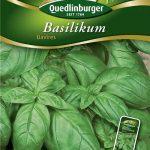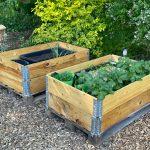I sincerely love Basil. Best used fresh, this herb an enrichment for for a lot of dishes from pesto to all kinds of pasta, also poultry and countless sauces and even soups. Always a great addition.
Unfortunately, Basil a is a little diva-ish to have around and grow. I f***ed up numberless times when I tried to grow or even just maintain my basil plants, but finally, meanwhile I seem to have developed at least a little knack for it. I have actually managed to germinate as well as propagate, grow, perpetuate and correctly prune several basil plants on my southern windowsill! Here’s what I can share:
Cultivation Overview:
Basil (Ocimum basilicum) belongs to the mint family or to the subfamily “Nepetoidea” and is related to herbs such as rosemary and sage. It’s rich in species with more than 60 therof. It prefers a sunny spot and diligent watering.
- Location: Sunny, warm and sheltered (e.g. garden, raised bed, balcony, windowsill).
- Soil: Nutrient-rich and permeable. Moderately moist.
- Fertilization: Moderate. For in-house culture, a little plain herbal fertilizer every 4 weeks.
- Watering: Moderate. The soil should never dry out completely, thus always be moist but not wet to prevent root rot. Water daily but sparingly, have an eye on that, it’s already half the battle.
- Overwintering: Unless you live in a mediterranean climate zone, perennial varieties sorts MUST be taken in-house.
Basil from the Supermarket:
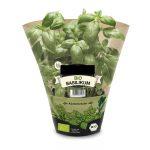 You can buy potted fresh basil plants all year round at any supermarket and if you just need some fresh herbs for your next dinner occasion, these are perfect: Buy, harvest and discard the empty pot – easy. Not so easy if you want to keep them for longer, maintain, grow or even propagate them.
You can buy potted fresh basil plants all year round at any supermarket and if you just need some fresh herbs for your next dinner occasion, these are perfect: Buy, harvest and discard the empty pot – easy. Not so easy if you want to keep them for longer, maintain, grow or even propagate them.
For economic reasons, Basil plants come in way too small pots. This is sufficient for the one-time-use but in case you want them to prosper on your windowsill, I strongly recommend unpotting them and cautiously breaking that small bush apart into 3 – 4 smaller parts. Then replant them in larger pots, providing them with a nutrient rich soil and sufficient watering.
Regrowing:
 You can also regrow Basil plants from cuttings. It takes patience, daily care and some attention, but it does work. I did it a few times now and with a little diligence, you can absolutely grow your own basil.
You can also regrow Basil plants from cuttings. It takes patience, daily care and some attention, but it does work. I did it a few times now and with a little diligence, you can absolutely grow your own basil.
Gather a strong stalk of a healthy plant: Cut it at the bottom, carefully clipping off all leaves and shoots on a length of about 6 cm (~ 2.5″). Put it in a small glass jar with clean and cool un-chlorinated water and place it in a warm and sunny spot. Change the water every other day or so.
The stalk will grow a bunch of delicate, white roots that, when they reach about 2-3 cm (~ 1″) in length, you can replant in moist potting mix.
Growing from Seeds:
You can buy basil seeds at the garden market or similar stores (I use the brand on the left). Basil seeds should germinate at about 20-25 °C (68-77 °F) in a small container and in full light, ideally under glass.
Basil is a light germinator, so the seeds should only be gently pressed into whatever substrate you use, do not cover with soil and keep slightly moist (not wet, to avoid rot) at all times. A spray pistol will come in handy.
Germination will take around 7-14 days, the seedlings can be separated when the they’re about 2-3 cm (~ 1″) tall and the seed leafs are fully developed.
Pruning/Plucking:
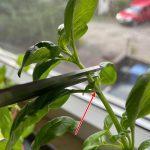 Harvesting your basil can add a lot to the plant’s growth as long as it’s done right.
Harvesting your basil can add a lot to the plant’s growth as long as it’s done right.
First, try to snip off any flower buds as soon as they appear, because they require a lot of energy from the plant that you want to go into leaves and bushiness, not into reproduction.
Second, when harvesting leaves start from the top of the plant (although this might seem counterintuitive) and try to find the leaf nodes on a stem. There are usually two large leaves and two tiny, fresh leaves growing from there. Snip about 1 cm above that spot. This will repeatedly urge the plant to grow more, making it bushier and more productive in the long run.
Gelbtafeln:
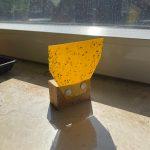 A very efficient and useful addendum to my basil nursery were “Gelbtafeln” – small, yellow, sticky plastic sheets to tuck into the soil or place close to the plant pots:
A very efficient and useful addendum to my basil nursery were “Gelbtafeln” – small, yellow, sticky plastic sheets to tuck into the soil or place close to the plant pots:
Unfortunately, most store-bought potting soils are contaminated with fungus gnat eggs or -larvae which will eventually evolve into gnats that in turn feed on the roots of the delicate little plants. Very detrimental. These yellow patches attract the tiny pests very efficiently without any chemicals and take them out of business.

